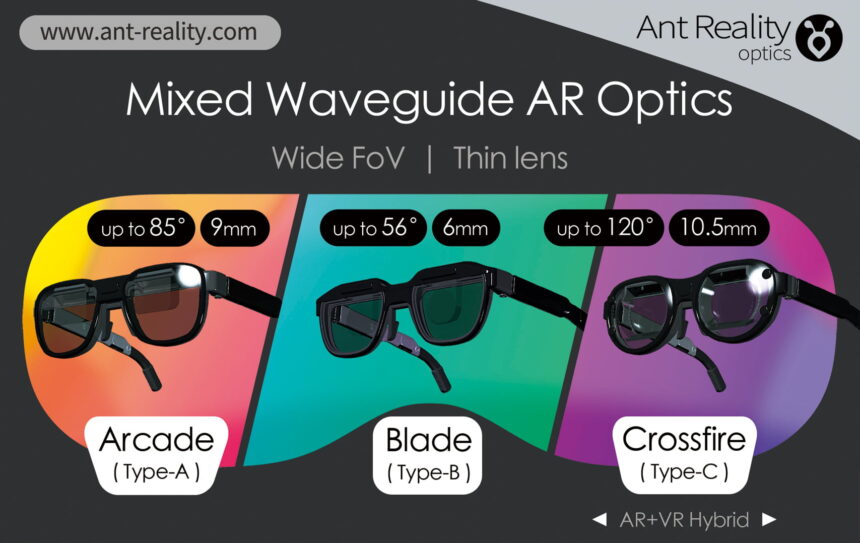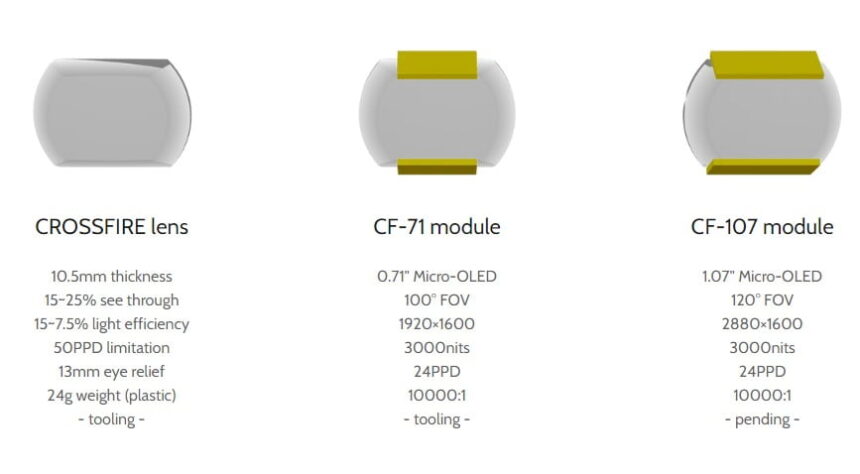New AR optics offer 120 degree field of view and switch to VR

Hardware maker Ant Reality is back with new AR optics that offer a wide 120-degree field of view and a seamless VR transition.
Crowdfunding aficionados may not have the best memories of the company AntVR. After troubled campaigns on Kickstarter and Indiegogo for AR and VR headsets, some backers waited years for their money.
After a temporary shutdown, AntVR is back under a new name. Ant Reality is working on licensable AR optics for headset manufacturers. Company founder Zheng Qin refused to accept failure. He is now working on AR technology on a smaller scale, according to an Indiegogo update from 2021.
Augmented reality with 120-degree field of view
Ant Reality's prototypes for AR and VR lenses with waveguide displays, which the company calls "Mixed Waveguide AR Optics," are particularly thin. The company unveiled the new device at CES 2023.
The "Crossfire" variant's specifications sound most impressive with a field of view of up to 120 degrees. Ant Reality does not explicitly state whether diagonal measurements were taken. In any case, the prototype would be well above the field of view of current AR headsets.
For comparison, the Magic Leap 2 (info) offers 44 degrees horizontally and 53 degrees vertically. The Hololens 2 offers 43 degrees horizontally and 29 degrees vertically. The "Crossfire" prototype thus already enters the realm of VR headsets like the Valve Index (review).
Qin's optics lab achieves the large field of view with two waveguide displays per eye. As RoadtoVR reports, these are located at the top and bottom of the lens, each displaying half of the image. The lens merges the two images. This trick could make both display pipelines relatively narrow.
Ant Reality explains that the Crossfire model's waveguide projector is integrated into the lens and a micro OLED panel is attached directly to the lens. The result, they say, is a nearly frameless optic for AR headsets.
The lenses, at almost half-an-inch thick, are reminiscent of eyeglass lenses for high diopter values. The lenses of the "Arcade" (about a third of an inch thick with up to 85 degrees field of view) and "Blade" (under a quarter inch thick with up to 56 degrees field of view) variants are somewhat thinner.
Switch between VR and AR at the touch of a button
A CES video (see below, 1:41) shows the second important feature in action. The transparent glasses have a dimming function. The prototype fades out the real world via LCLV (Liquid Crystal Light Valve).
This makes it possible to play virtual reality in front of an almost black background. At CES, Ant Reality demonstrated this function on permanently mounted glasses. According to RoadtoVR, around 90 percent of the outside light is blocked.
The Magic Leap 2 also offers active dimming, but to a lesser extent. The effect is primarily used to compensate for bright light conditions in outdoor AR applications.
The final cost of Ant Realities' AR solutions is expected to be less than $30 per lens. For production, the company has announced a partnership with Goertek, which also manufactures VR headsets for well-known brands such as Meta.

Ant Reality offers its AR optics in three variants: "Arcade" for AR gaming, "Blade" for everyday use, and "Crossfire" for hybrid use. | Image: Ant Reality
AntReality names Nreal and Realmax as the first licensees of the AR optics. A possible successor of the Nreal Light could be released with Ant Reality optics and a larger field of view.
Note: Links to online stores in articles can be so-called affiliate links. If you buy through this link, MIXED receives a commission from the provider. For you the price does not change.
